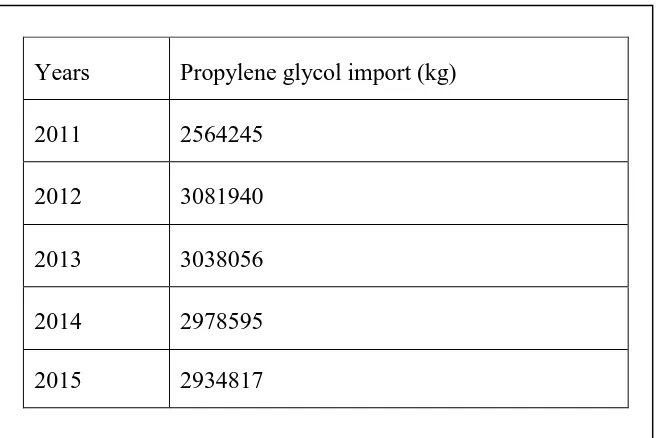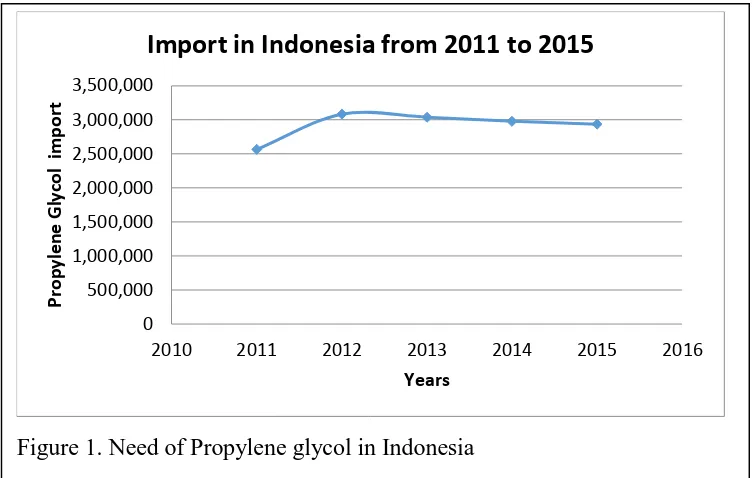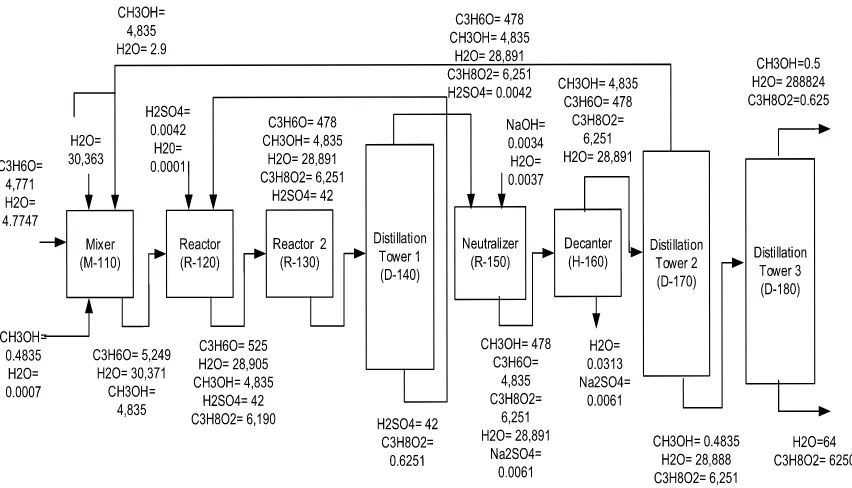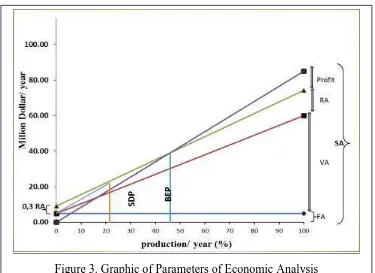PRELIMINARY DESIGN OF PROPYLENE GLYCOL PLANT
FROM PROPYLENE OXIDE AND WATER USING ACID CATALYST
CAPACITY OF 50,000 TON/YEAR
PUBLIKASI ILMIAH
Disusun sebagai salah satu syarat menyelesaikan Program Studi Strata I pada Jurusan Kimia
Fakultas Teknik
Oleh:
AISYAH HANIFAH
D 500 122 004
PROGRAM STUDI TEKNIK KIMIA
FAKULTAS TEKNIK
UNIVERSITAS MUHAMMADIYAH SURAKARTA
1
PRELIMINARY DESIGN OF PROPYLENE GLYCOL PLANT
FROM PROPYLENE OXIDE AND WATER USING ACID CATALYST
CAPACITY OF 50,000 TON/YEAR
Abstrak
Di Indonesia, pabrik propilen glikol adalah industry yang menawarkan kesempatan baik untuk Negara. Propilen glikol dihasilkan dari reaksi propilen oksida dan air menggunakan katalis asam dengan perbandingan propilen oksida: air: methanol adalah 43,04: 802,8: 71,87 lbmol. Proses menggunakan reaktor RATB (Reaktor Alir Tangki Berpengaduk). Reaktor beroperasi pada suhu 30°C dan tekanan 1 atm. Reaksi pada reaktor berjalan pada kondisi fase cair, irreversible dan eksotermis. Unit pendungkung dari pabrik terdiri dari unit penyedia air, unit suplai uap air, listrik dan kebutuhan bahan bakar dan laboratorium untuk menjaga kualitas bahan baku dan produk dalam keadaan standar. Perusahan ini adalah perusahaan perseroan terbatas (PT) dengan system organisasi terstruktur dan pegawai. Perusahan ini terletak di Gresik profinsi Jawa. Terlihat dari analisis ekonomi bahwa Percent Return on Investment (ROI) sebelum pajak adalah 25.42 % dan ROI setelah pajak adalah 17.79 %. Pay out Time (POT) sebelum pajak adalah 2.8 tahun. Break Even
Point (BEP) adalah 45.96 %, Shut down Point (SDP) adalah 21.51 %, menghasilkan
Discounted Cash Flow (DCF) 30.28 %, dari data analisi yang didapatkan, bisa
disimpulkan bahwa pabrik menguntungkan dan kemungkinan untuk dibangun.
Kata Kunci: propilen oksida, katalis asam, air, RATB.
Abstract
In Indonesia, propylene glycol plant is an industry that can provide a good opportunity for the country. Propylene glycol is produced by a reacting of propylene oxide and water using an acid catalyst by a ratio of propylene oxide: water: methanol is 43.04: 802.8: 71.87 lbmol. The process using CSTR reactor (Continuous stirred tank reactor). The reactor operates at temperature of 30°C and a pressure of 1 atm. The reaction in the reactor is carried out at liquid phase, irreversible, and exothermic condition. Supporting units of the plant consists of the units of the water provider, the unit of steam supply, electricity and fuel needs, and laboratories to maintain the quality of materials and products to conform to the standards. This company is a limited liability company (PT) with a system of organizational structure and staff. The company is located in Gresik Java Province. The economic analysis showed that Pretax Percent Return on Investment (ROI) is 25.42 % and ROI after tax is 17.79 %. Pay out Time (POT) before taxed is 2.8 year. Break Even Point (BEP) of 45.96 %, Shut down Point (SDP) of 21.51 %, and was obtained Discounted Cash Flow (DCF) of 30.28 %, were obtained the data feasibility analysis, it can be concluded that the plant is profitable and feasible to be established.
Keywords: Propylene Oxide, acid catalyst, water, CSTR
BACKGROUND
Propylene glycol is one of the chemicals that are used as industrial raw materials, particularly
2
food, and pharmaceutical industries as an antifreeze when leakage might lead contact with food. The
food and Drug Administration (FDA) has classified Propylene glycol as an additive that is “generally
recognized as safe” for use in food and as additives in paint industry (Kirk and Othmer, 1992).
In Indonesia, Propylene glycol plant is one of the industries that provide good opportunities
for the country. Indonesia has not been able to meet the needs of Propylene glycol, so that Indonesia
still imports from other countries. Because of the inability of producers to meet all the demand
Indonesia depend on imports from other countries.If the Propylene glycol plant is built, the benefits
are:
A. Create jobs for the people in Indonesia.
B. Adding foreign exchange.
C. Propylene glycol needs can be met without imports from other countries.
D. Encouraging the development of the Plant that use Propylene glycol as raw materials.
E. It is expected to penetrate the export market.
METHOD
Indonesia is a country that has not been able to meet all the needs of Propylene glycol, so that Indonesia
imports it from overseas. It can be seen from the increase in data import of the year 2011 to 2015 (BPS,
2015), as shown in the Table 1
Table 1. Import of propylene glycol in Indonesia from 2011 to 2015
Years Propylene glycol import (kg)
2011 2564245
2012 3081940
2013 3038056
2014 2978595
3
The increase in the imports of propylene glycol are consistent with the equation of a straight
line:
y = 63780x - 1E+08 (1)
From this equation, it can be estimated that propylene glycol import in 2020 will be equal to 28,835.6
Tonnes/year. Based on that estimated need for propylene glycol above, the plant capacity is then
determined to reach 50,000 tonnes/year.
2.1 literature review
Propylene glycol can be produced by the hydrolysis of propylene oxide with excess water and Can
also by adding methanol as a diluent for propylene oxide is not soluble in water.
Production of propylene glycol can be done by 3 processes, among others:
Hydration of propylene oxide without a catalyst
CH2– CH – CH3 + H2O → CH3– CH – CH2 (1)
O OH OH
The conversion of propylene oxide hydration process without catalyst reaches 90%. This process takes
place at temperatures of 120-190°C at a pressure of 2,170 kPa (Kirk and Othmer, 1992).
Hydration of propylene oxide with a catalyst
H+
CH2– CH – CH3 + H2O → CH3– CH – CH2 (2)
O OH OH
Figure 1. Need of Propylene glycol in Indonesia
0
2010 2011 2012 2013 2014 2015 2016
P
4
At Chan and Seider study in 2004 using ratio of propylene oxide: water: methanol: sulphuric acid as a
catalyst is 43.04: 802.8: 71.87: 20 lbmol. Operating conditions of process is temperature of 77-93°F
with a pressure of 1 atm, obtained a conversion of 99% (Chan and Seider, 2004).
Looking at the process conditions and the resulting conversion on every production process propylene
glycol above, the selected process is the hydration of propylene oxide with an acid catalyst.
2.2Overview of thermodynamics
Hydration propylene oxide to propylene glycol it shows K >>>1, that mean the reaction is irreversible.
Table 2. ΔG°f value each components (Yaws, 1999)
No Component ΔG°f 298 K (kJ/mol)
ΔG°f = StandardGibbs free energy(kJ/mol)
K298K = Equilibrium constant
K298K = EXP (ΔG°f
−�� ) (3)
= EXP ( / o . ��.� � � )
= 601,116,015.4504
Value equilibrium constant of the reaction at temperature 30°C:
5
Because the value of K is large, so this reactions is irreversible.
2.3 Kinetic Review
The reaction can be modeled with power-law kinetics that is first order in the propylene oxide
concentration, with a rate constant given by:
-rA = kCA (4)
k = A exp (-E/RT) (5)
Note:
k = Equilibrium constant
CA = propylene oxide concentration (kmol/jam)
A = factor pre exponential
Process stage consist of 3 stage
1.Raw materials preparation stage.
This process is done by mixed the raw material propylene oxide, water and methanol. Charge a mixture
of 43.04 lbmol of propylene oxide, 802.8 lbmol of water and 71.87 lbmol of methanol. In addition,
methanol is added to prevent phase splitting because propylene oxide is not completely soluble in
6
from the distillate of the distillation tower (D-107). Results of the mixer is put into the continuous
stirred tank reactor (R-120).
2.Reaction stage.
In this stage using the optimization and got the number of reactors, the reactor is used as 2 tools, in the
first reactor R-120 conversions is 90% and the second reactor R-130 has conversation 99%. The
reaction takes place at 30°C and 1 atm. In the reactor R-120 also added sulfuric acid catalyst. The
reaction is exothermic, so that the reactor needs to be given a coil to maintain a stable operating
temperature and to keep the reaction in the liquid phase.
3.Neutralization stage.
Product from reactor R-120 as feed to the MD-140 to recycle a sulfuric acid catalyst to be used again,
then transferred to the neutralizer. Charge Reactor Tank with 0.4078 lbmole of sodium-hydroxide.
React in unit Reactor Tank R-150 via Neutralization Reaction. The reaction is Adiabatic. Transfer
contents of unit Reactor Tank to Distillation tower D-170.
4.Purification products stage
In this stage aims to purify the product is still mixed with propylene oxide and methanol. Products
from neutralizer input in decanter H-160 to precipitate the sodium sulfate is formed than transfer to
distillation tower D-170. Distillate product from D-170 are propylene oxide, methanol and water as
the recycle into the mixer and bottom products are Propylene glycol and water was fed to the D-180
to obtain a purity of 99%.
7
3.2Main Equipment
3.2.1 Specification of Mixer (M-110)
Kind : Cylinder tank with stirrer
Function : Mixed water, propylene oxide and methanol before reacted in the
reactor
Material construction : Carbon steel
3.2.2 Specification Reactor 1 (R-120)
Type head : Torispherical head
Material construction : SA 304 grade C
8
Type : Continuous Stirred tank
Conversion of Reactor : 99 %
3.2.3 Specification distillation tower 1 (D-140)
Code : D-140
Function : separated sulphuric acid to use again in Reactor-120
Type : Plate Sieve Tray
Material construction : Carbon steel
Operational condition : Continue
Distillate Pressure and Temperature : 1 atm and 95.163°C
Bottom Pressure and Temperature : 1.1 atm and 272.836°C
Specification
Diameter : 2.7542 m
Height : 43.0356 m
Number of plate : 94
3.2.4 Specification neutralizer
Function : To neutralized distillate D-140 used NaOH
Type : continuous Stirred tank
Type head : Tori spherical head
Material construction : SA 204 grade C
3.2.5 Specification Decanter
Function : To separated Na2SO4
Operation : Continue
Specification
Type : Continuous Cylinder Horizontal
Volume : 5.9145 m3
Length : 4.9562 m
Diameter : 1.4444 m
Space time : 10 minute
9
Function : To recycle propylene oxide and methanol to used again in Mixer-110
Type : Plate Sieve Tray
Material construction : Carbon steel
Operational condition : Continue
Distillate Pressure and Temperature : 1 atm and 95.163°C
Bottom Pressure and Temperature : 1.1 atm and 272.836°C
Specification
Diameter : 2.7542 m
Height : 43.0356 m
Number of plate : 94
3.2.7 Specification distillation tower 1 (D-180)
Function : to purify Propylene Glycol products up to 99.99%
Type : Plate Sieve Tray
Material construction : Carbon steel
Operational condition : Continue
Distillate Pressure and Temperature: 1 atm and 99.4 °C
Bottom Pressure and Temperature: 1.1 atm and 178.3°C
Specification
Diameter : 2.415 m
Height : 15.214 m
Number of plate : 32
3.3 Feasibility Analysis
The feasibility analysis is to determine the benefits plant. Whether profit relatively large or small.
Based on the results of the economic feasibility analysis we concluded that propylene glycol plant is
10
CONCLUSION
Propylene glycol factory belonging to a factory with lower risk. This is because the operating
conditions are at a pressure of 1 atm and a temperature of 30 ° C.
The economic feasibility analysis of propylene glycol plant is expressed as follows:
1.Profit before tax of Rp 140,611,465,467 every year and profit after tax of Rp 98,428,025,827 every
year.
2. ROI (Return on Investment) before taxes is 25.42% and after tax is 17.79%. The minimum ROI
(Return on Investment) before tax for low-risk plant of 20% (Aries and Newton, 1995).
3. POT (Pay Out Time) before taxes is 2.82 year and after tax is 3.6 years. The maximum POT (Pay
Out Time) before tax for low-risk plant of 5 years (Aries and Newton, 1995).
4. BEP (Break Event Point) is 45.96% and SDP (Shut Down Point) is 21.51%. BEP for chemical plants
generally range between 40-60%
5. DCF (Discounted Cash Flow) is 30.28%, DCF is acceptable must be greater than the interest on
bank loans. The amount of low-risk plant DCF for a minimum of 1.5 times the amount of interest the
bank.
BIBLIOGRAPHY
Aries, R.S., and Newton, R.D. 1955. Chemical Engineering Cost Estimation , Mc Graw-Hill Book Co. Inc, New York.
11
Badan Pusat Statistik. 2015. Statistik Perdagangan Luar Negeri Indonesia.Jakarta.
Brown, G. G., Unit Operation, John Wiley and sons, Inc, New York.
Brownell, L. E., and Young, E. H. 1979, Process Equipment Design, Wiley Easthern Limited, New Delhi
Chan, Arthur., and Seider, warren D., 2004, Batch Manufacture of Propylene Glycol, Department of Chemical and Bimolecular Engineering University of Pennsylvania, Pennsylvania
Coulson, J. M. and Richardson, J. F., 1983, Chemical Engineering, 1st edition, volume 6, Pergason
Press, Oxford.
Faith, W.L., Keyes, D.B., and Clark, R., 1957, Industrial Chemical, John Wiley and Sons Inc, London
Kern, D.Q., 1950, Process Heat Transfer, Mc. Graw-Hill International Book Company Inc., New York.
Keyes, F., and Clark, R.S., 1959, Industrial Chemistry : 4 th edition. John Wiley and Sons, Inc, New York.
Kirk, R.E., and Othmer, V.R. 1998. Encyclopedia of Chemical Technology : 4th ed. John Wiley & Sons Inc., New York
Perry, R.H. and Green, D.W. 1999. Perry’s Chemical Engineer’s Handbook, 7th ed. McGraw-Hill
Book Company, New York
Peter, M.S. and Timmerhaus, K.D. 1980. Plant design and Economic for Chemical Engineers, 3rd edition, Mc Graw-Hill Book Company, Tokyo.



